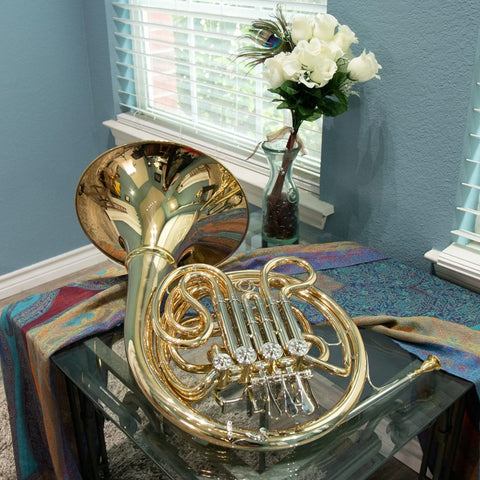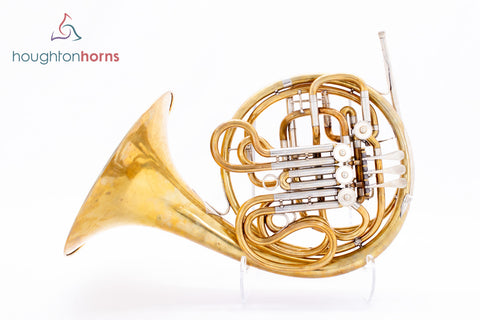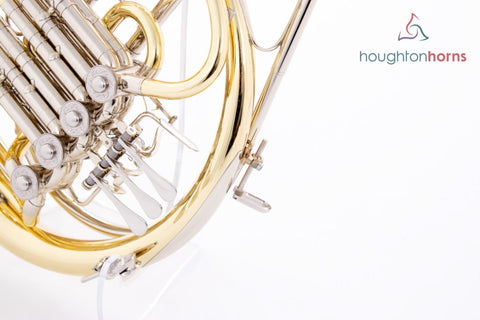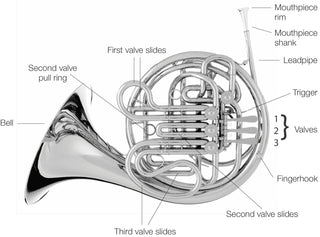You might hear a French horn being described in terms of “bore size” or “lever action”. But what do these terms mean? Here’s an introduction to some of the terminology all horn players need to understand.

Fixed bell

The bell flare is attached to the body of the horn. We generally suggest fixed bell horns to younger students. They are more durable because the bell cannot be dropped or misplaced while separated from the horn. There is no need to worry about warping the screw threads while taking the bell on or off.
Detachable bell / screwbell

The bell flare unscrews from the body of the horn to be stored separately. Advanced players oftentimes own multiple bells which they can switch out to obtain a specific sound.
Older and more responsible students might want to consider moving up to a detachable bell, because unscrewing the bell allows you to fit the horn into much smaller cases. They are much more portable and easy to travel with than fixed bell horns.


Material
Gold brass is the softest metal with the most mellow sound. Yellow brass is in the middle, so it’s mellow at softer dynamics but brassy at higher dynamics. Nickel silver is the hardest, brightest-sounding metal, usually found on large horns to balance out the sound. It has the best dent resistance.
Material is a matter of personal preference. Consider asking your teacher for their recommendation, or choosing a metal that best matches the sound of the other musicians in your ensemble.



Finish
Some people like lacquered instruments because they maintain that like-new shine for years. Long-term, though, the lacquer will start to wear off and pit and the horn may need to be de-lacquered.
Many of our professional musicians at Houghton Horns prefer unlacquered instruments because they sound, to the faintest degree, slightly freer and more open. However, an unlacquered instrument will start to tarnish immediately after purchase.
It ultimately comes down to personal preference either way.


Bell size and manufacture
The larger the bell, the broader and less defined the sound of the horn. Smaller bell sizes will sound more focused.
Bells are usually either described as “spun” or “hand-hammered”. Every bell starts out as a flat sheet of metal that is folded into a 3-D flare shape and soldered shut, but there are two primary ways of getting there.
A spun bell starts as a thicker disc of metal that is flattened into the correct shape by a machine, then bent around a spinning metal lathe and and soldered. Spun bells tend to be thinner and lighter and have a clearer sound.
But some master craftsmen still shape the bells by hand, using centuries-old techniques. They cut the metal out of a larger sheet, then fold it over and hammer it onto a mold. Then they solder the bell shut at the seam and use a press to firmly fit the bell onto the mold. Hand-hammered bells tend to be thicker and have a warmer sound with more tonal colors.

Lever action
If you look at the back side of a horn’s valves, they are either pulled by string (string linkage) or a metal arm (mechanical linkage).
String is quieter and maintains better mechanical advantage, so it tends to feel very light and quick. It can deteriorate or snap unexpectedly, so it will need to be periodically replaced.
Mechanical linkage is often noisier, and has a heavier feel. As it does not require re-stringing, it will be faster to re-assemble after maintenance. The screws might fall out, so keep a few extras handy.


Bore size
The width of the cylindrical tubes that make up the larger part of the horn is called the “bore”. Most horns have a bore size of .468 to .472 inches, somewhere around 12 mm. The larger the bore, the warmer the sound. Smaller bore instruments have a brighter sound.
Manufacturers design their horns to provide a balanced sound. For example, a piercing and sharp nickel silver metal might be shaped into a larger bore to temper the sound.
Valves
Most double horns have four valves made out of solid yellow brass.
The standard four valves send air moving through the first, second, and third slides and the F/Bb trigger. Occasionally you may see a fifth stopping valve, which is used to play stopped horn without transposing and with better intonation.
Some horn makers have released double horns with five valves, such as Hans Hoyer’s C12, but these have never really caught on.
Although solid brass valves are the most common, recently some manufacturers have released different types of valves, such as Finke’s composite valves or Patterson’s hollow valves. These newer valves tend to be lighter, which can be helpful for the player as the valves are the heaviest part of a horn. Additionally, with less mass they turn quicker, meaning slightly faster action. Also, Paxman has some titanium valves, which are more durable and will last longer than a normal brass valve. But before switching to a new type of valve, beware that there may be an adjustment period as you adapt to the unfamiliar valve action.

Thumb lever / thumb valve / trigger
Double horns have a thumb lever, a little switch a player pushes with their thumb to flip the horn from the key of F to Bb (or vice versa). This thumb lever might be fixed in place, but sometimes it is adjustable, to provide a more ergonomic fit.

Wrap
Nowadays most horns are called either a “Geyer wrap” or “Kruspe wrap”. These are the two primary ways in which the valves and tubes are arranged on the horn.
Edward Kruspe is generally credited with building the first double horn in Germany in the 19th century. On his horns the 1st, 2nd, and 3rd valves are all lined up in a row, and the F/Bb valve is set a little further back closer to the player’s thumb. There are more bends in the tubing, resulting in more resistance and a darker, more covered tone. An extra water key can fit on a Kruspe wrap to make it easier to empty the water out.
Carl Geyer built horns in Chicago in the early 20th century. All four valves on his horns were lined up straight in a row. There are fewer bends in the tubing, so it is easy to slur notes but the initial attack might be more challenging. Geyer-wrap horns tend to have a brighter sound with more tonal colors.
Neither wrap is better than the other, but the Geyer wrap has become more common in the United States over the past 30 years.


Finger hook / pinky hook
Many horns have a little metal hook attached to the side where players can loop their pinky finger. They are either fixed in place or adjustable. Adjusting the pinky hook is an easy way to make a horn more easily fit a smaller or larger than average hand, and can be done with a small hex wrench that might be included with your horn at purchase.
A repair shop can upgrade most horns to an adjustable pinky hook upon request.

Hand rest / duck’s foot / adjustable flipper
Horns sometimes have an extra metal flipper which rests on the webbing in between the player’s pointer finger and thumb. This will take some of the weight of the horn off the pinky finger and make it easier to hold for long periods of time.
Most flippers are designed to flip up when the horn is in use, then flip down to be stored in the case.
A repair shop can install an adjustable flipper on almost any horn. They are adjusted by loosening screws with a standard small screwdriver.

Water key
As the player blows into their instrument “condensation” (it’s totally spit, but good luck getting a horn player to admit to it) builds up inside the tubing of the horn. This water needs to be poured out occasionally, or the sound of the horn becomes increasingly gurgle-y. Also, leaving water sitting inside a brass instrument for long periods of time is terrible for the metal.
A water key is a little release valve on the tubing of the horn that you can open to shake the water out. Traditionally they were levers sealed with cork, but nowadays you might also see an Amado key (piston-operated valve) or Joy Key (porous automatic valve). There are advantages and disadvantages to each model, but most horn players find having any water key at all is better than none. In fact, some players have 2-3 water keys installed at different locations around the horn for faster water removal.

Understanding Horn Specification Charts
Here is the specifications chart for our new Verus KX horn. With what you learned above, can you read it?
|
Specifications |
|
|
Type |
Double Horn F/Bb |
|
Body |
Yellow Brass |
|
Bell |
Yellow Brass, Spun |
|
Bell Size |
Medium-Large |
|
Bell Type |
Detachable |
|
Finish |
Unlacquered |
|
Lever Action |
String |
|
Leadpipe |
Yellow Brass |
|
Bore Size |
11.9 mm (.468") |
|
Valve Rotors |
Solid Brass |
|
Valve Casing |
Yellow Brass |
|
Number of Valves |
4 |
|
Finger Hook |
Adjustable |
|
Thumb Lever |
Adjustable |
|
Hand Rest |
None |
|
Water Keys |
1, Amado-style |
|
Weight |
5.29 lb
|
|
Mouthpiece |
Your choice of Verus VX one-piece mouthpiece |
|
Case |
Verus clamshell ABS flight case |
Did we leave anything out? Please ask questions in the comments so we can expand upon this article in the future.


Anonymous
Hi Jackson, no, each model of horn has different size rotor arm screws. Please call our repair shop at 817-993-6400 ex 2 and give them the make and model of your horn. They will be able to order replacement parts for you.
Anonymous
Hi Larry, please contact our repair shop at 817-993-6400 ex 2 and they can hook you up with Conn replacement parts.
Jackson Hatcher
Hi, I was wondering, are the screws on the rotor arm that keep the string in place all the same size? The one on my horn broke and I don’t know what to do.
Larry Umipeg
Hello. I have a Conn 8D Horn (GD740047). The "post"’s where the string goes around all have grooves from the action of many years and now actually cuts through the string much like a knife. So, I was wondering if those partes could be replaced by new ones. If so, I would like to order 4 of said posts. Where might I inquire about these partes? Thank you very much!